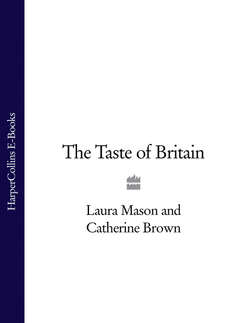Читать книгу The Taste of Britain - Hugh Fearnley-Whittingstall - Страница 116
HISTORY:
ОглавлениеBath has long been an important pleasure and health resort. Bath buns are one of several distinctive foods which became famous as the town grew during the eighteenth century. The Bath cook and author Martha Bradley (1756) gave a recipe for a Bath seed cake which appears different to other seed cakes in its use of wine and rose water. This instruction came, in fact, from Bradley’s lengthy quotation of an earlier household manuscript, possibly dating from the seventeenth century. Elizabeth Raffald (1769) tells how to cook ‘Bath Cakes’, which are caraway (seed) cakes shaped into buns. The light, yeast-leavened rolls were enriched with cream and butter, but no eggs. Some caraway comfits were worked into the dough and more were strewn over the top. This recipe is repeated in Farley (1783) - a work largely derivative of Raffald - and Henderson (c. 1790), a work largely derivative of Farley. When Henderson was re-edited by J.C. Schnebbelie (1804) the tide of the recipe was transformed to ‘Bath Cakes or Buns’. While Raffald sent her cakes in ‘hot for breakfast’, Farley, Henderson and Schnebbelie suggested they be eaten at either breakfast or tea. A cookery book produced in the Midlands in 1807 calls them Bath buns (Simon, 1960). The proportions are very similar to those in Raffald, except some of the cream is replaced by egg. It, too, deploys caraway, a defining ingredient in these early recipes.
That Bath buns were not universal in the city during the Georgian era may be inferred from the letters of a visitor who never stinted his descriptions of food and drink. John Penrose wrote in 1766 (Penrose, 1983): ‘…with our Tea Cambridge-Cakes buttered. We have had these too ourselves. They are round thick Cakes, a penny apiece, hardly an Ounce weight; look like Dow [dough], all white and soft: these we toast a little by the fire, just to warm them through, and then butter them; they eat exceedingly well.’ Were his Cambridge cakes the forerunners of Bath buns? Jane Austen refers to ‘disordering her stomach with Bath bunns’ in a letter of 1801 (Austen, 1995).
Meg Dods (1826) included recipes for both Bath cake and Bath buns in her description of English specialities. She likened the dough to the French brioche (it included eggs and butter) and suggested caraway seeds for the cake and caraway comfits (sugar-coated) for the buns. Neither cake nor buns were described in the Victorian cookery bibles of Eliza Acton and Isabella Beeton, although the buns occur in Mrs Marshall (1887), retaining their spicing with caraway. The nineteenth century, however, does seem to be the period when Bath buns underwent considerable change and normalization, losing for the most part their distinctive caraway flavour and gaining the now-accepted adornment of nib sugar as well as candied peel or grated citrus zest and dried fruit.
The defining moment appears to have been the Great Exhibition of 1851. The catering contractors served Bath buns in their tens of thousands (David, 1977). This led to the development of a ‘Cheap Bath or London bun’ described by Kirkland (1907) which was little more than a bun with eggs, orange peel, sultanas and a final ornament of nib sugar. The fat used was lard.
The general move away from caraway is confirmed by Dallas (1877), who suggests a plain brioche dough for Bath buns and Skuse (1892), who advises lemon zest.
In the town of Bath, buns made from a recipe adapted from one dated 1679 are still available. It was used by James Cobb, who founded his bakery in 1866. It does not deploy caraway, except in a residual addition of a pinch of mixed ground spice. The firm of Cobb’s continued to trade until the late 1980s, when the business and recipe were acquired by Mountstevens Ltd, who continue to make the buns and have several shops in Bath itself. Beyond the town, it is largely the ‘cheap or London’ variety that is produced.
The sun is shining at Stroud Farmers Market. It is shining on four fruit and vegetable stalls, three of them organic, piled high with broad beans; tufted carrots; young beetroot complete with emerald tops; red-skinned potatoes, white-skinned potatoes, yellow potatoes, potatoes blotched pink and white, with their names scrawled on bits of cardboard - Pink Fir Apple, Desiree, Pentland Javelin, Charlotte, Duke of York; shaggy, multifarious salad leaves; onions and shallots; crisp cabbages. It is shining on boxes of white cherries, Merton Glory, blushed down one side, and others of gooseberries as green as opals. It is shining on seven meat stalls, among them offering Gloucester Old Spot and Tamworth pork, Gloucester Long Horn and Hereford beef, Cotswold lamb, tree-range chickens from Chepstow and Aylesbury ducklings, and game - rabbit as well as fallow and muntjack venison from the countryside about. It shines on two bread stalls, two cake stalls, two stalls selling apple juice, perry and cider; another with fresh trout, trout pâté and watercress; and on three cheese stalls, one of which has sheeps’ milk cheeses coated in ash stacked up like so many small square turrets.
I lurch away up, laden with a couple of chickens from Chepstow, belly pork from Minchinhampton, green back rashers from Dursley, a kilo of carrots from Highrove, kale tops from Wotten, a bag of cherries, a large lump of extra mature Double Gloucester and a Dublin loaf from the WI stall. Second helpings anybody?
Matthew Fort
COOKERY WRITER AND BROADCASTER
